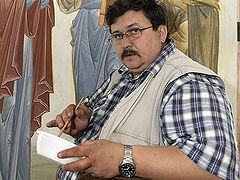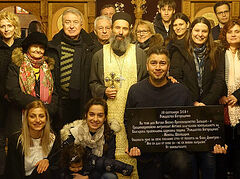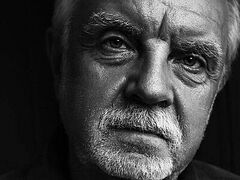 Painting of the interior of the Church at the Russian Pilgrim’s Residence at the site of Baptism of Jesus Christ (Jordan)
Painting of the interior of the Church at the Russian Pilgrim’s Residence at the site of Baptism of Jesus Christ (Jordan)
—As you look around at the painted church walls, you are oftentimes unable to view it as an organic whole because you notice how one fragment was made by one painter, the next one by another, and so on… Why does this happen?
I think it is a problem of timing and the speed of painting. It often happens that a spacious church has to be painted within a short time. A couple of iconography teams are invited to work there. In this case, even if there were a general design concept, it would still be hard to avoid the feeling that the frescoes lack artistic consistency. When we are assigned to do large-scale jobs, it is necessary to assign to the teams their segment of the church to keep it uniform in those zones, at least. For example, the mosaics of the Hagia Sophia in Constantinople were installed over a few centuries, at various historical periods, and by separate mosaicists respectively. In this case, what unites them is the architecture…
The same can be said about the iconostasis: the tiers of Deusis, the Prophets, and the Twelve Great Feasts are usually created as a whole by one or two iconographers, whereas the Local tier consists of the locally honored icons, and their style or period of creation is irrelevant. This happens, and it causes no discord.
I agree though that the unified design concepts, be it mosaics, frescoes, or iconostasis, strike a greater effect on a viewer because of their wholeness.
—You are working on the frescoes and mosaics in Diveyevo. Please tell us what have you completed so far?
 Painting of the Trinity Cathedral in Diveyevo.
Painting of the Trinity Cathedral in Diveyevo.
We have finished the painting of the Trinity Cathedral, the location of the relics of St. Seraphim of Sarov.
We are currently working on the mosaics in the new Annunciation Cathedral where we have completed the main figures and the central compositions.
Diveyevo, its history and culture, as well as its architecture and design, is largely associated with the nineteenth century, so our idea to retrospect towards an earlier iconographic language didn’t elicit an immediate response. It all worked out well later when we decided to go with the classical icon-painting stylistics that offers a realistic view of human body forms, proportions, movements, and a certain depth in the interpretation of form.
Blessing of St. Seraphim of Sarov
 Painting of the Trinity Cathedral in Diveyevo.
Painting of the Trinity Cathedral in Diveyevo.
—How did it happen that after finishing the Moscow Public School of Art, you decided against going to the Art Academy but started iconography school instead?
—There was a gap of five years between these two events: I served in the army for two years and later taught for three years at the children’s art school in my hometown of Kulebaki in Nizhny Novgorod province (called Gorkovskaya province at the time). That’s when I gradually got interested in Church, and it didn’t even have to do with icons. I came there seeking a higher purpose and religious foundation, while my interest in iconography developed later.
—I always wondered about the connection between man and his faith, and what the life of a religious person is like. I met some Orthodox men among my fellow conscripts. That’s when I got a hold of a Bible for the first time in my life. I also have a friend, Kostya Kovalchuk—we studied together at the Moscow Public School of Art. It so happened that we later served in the army together in neighboring squadrons. As I was watching my army buddies, I felt the desire to walk the path of faith myself.
 Narthex of the Holy Trinity Cathedral, Holy Trinity St. Sergius Lavra. Painted in 2008.
Narthex of the Holy Trinity Cathedral, Holy Trinity St. Sergius Lavra. Painted in 2008.
—When did you understand that you wanted to work as a professional iconographer?
—As I left the army, I wanted to continue my education and considered entering the Surikov Art Institute. But the rector of a local church in Kulebaki where I went told me that Moscow’s Theological Academy has just opened an icon-painting school. I was among the first students who enrolled there. I had to apply for admission and traveled from my native town, intermittently taking a train or a bus there as I would travel via Murom and Vladimir. It was the summer of the translation of the relics of St. Seraphim of Sarov, but I wasn’t aware of it.
I happened to be inside the Holy Trinity Cathedral in Vladimir where I was studying Andrey Rublev’s frescoes. There was a downpour outside. When I exited the cathedral the earth and the asphalt were steaming wet, so that the town was enveloped in fog. Next, out of this fog, came the sound of Paschal singing. In the middle of the summer!
I looked around and saw that police were circling the area where I was, blocking me inside the security cordon. The tips of the icon banners prodded through the fog and we could see the cross procession with the Patriarch at its head. Only later did I understand what had happened, so I venerated the relics, and, freshly inspired and invigorated, continued on my way to the iconography school.
—Can you tell us about fresco painting?
—We explain to our apprentices that “fresco,” in a classical way, is a modern term. In ancient times, in Byzantium, and later in Old Rus, this technique had a different name. It became known as a fresco in Italy in the fifteenth century. In the chronicles, we can find the description of a “wall painting on a freshly-applied chalk underpainting.” By the way, the fresco of the East, contrary to its Western counterpart, wasn’t always applied to a wet surface. For example, the lapis-lazuli background was painted over a fully dried wall for process-related reasons. Time has shown that whatever was painted over a wet surface lasted longer, because the painting mixes with the surface material and becomes one.
—Why then do you rarely see frescoes in modern churches?
—The customer has to resolve to do fresco. To paint a fresco, we need to have the walls ready. Modern paints, such as zinc-silicate paints, allow for all surfaces to be prepared at the same time, so the painting may begin right away. With frescoes, you need to plaster one section of the wall at a time in addition to watering it for a few days, so it does create obvious inconveniences. However, if the customer has resolved to do it, it results in a “stiff” painting. Besides, frescoes possess an unmatched color tonality.
 Sketch of the Annunciation. Belgorod, 2007.
Sketch of the Annunciation. Belgorod, 2007.
One more detail: When you are painting a fresco, you can’t make a mistake, as it can’t be fixed. It is so unforgiving. In other words, fresco is a very demanding art and it reflects the level of a painter’s expertise.
—A painter working on a church project has to work high up in the scaffolding. Have you ever gotten into any dangerous situations?
—Yes, once. I needed to make one last stroke of the brush, the same lapis-lazuli, only a lighter shade. It was a tiny stroke, so small it may not have even been noticed from down below. I kept stretching and stretching further out right beneath the dome, when the ladder folded under my feet… I fell and went down a few flights of scaffolding but somehow managed to find my footing. My fall slowed down and I landed on one of the lower-level wooden platforms instead of a bare floor at the bottom. I did break some ribs though… I was working alone, and so no one could hear me or offer help. I somehow was able to get down from the scaffolding, and then spent the next few days in bed.
When you work on monumental art projects, you don’t think of your job as dangerous or complicated, because you cradle a greater goal in mind—how to paint this particular image and specific composition so that they look as precise and expressive as possible.






